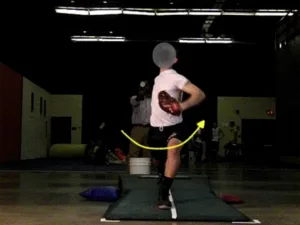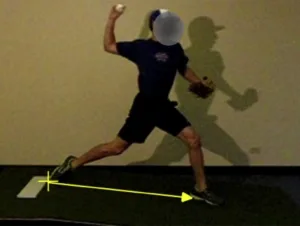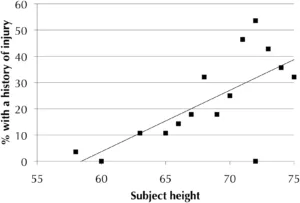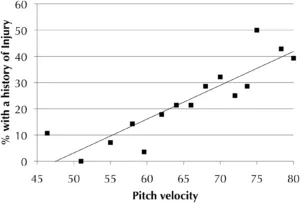 Are you searching for How Does a Pitcher's Height Affects Velocity and Injury? This is the article you need!
Are you searching for How Does a Pitcher's Height Affects Velocity and Injury? This is the article you need!
A pitcher's success in the high-stakes game of baseball is a complicated interaction of different factors that contribute to both longevity and performance on the mound. The role of a pitcher's height is a topic of continual dispute in the baseball community. Is there an inherent advantage to being taller when throwing at higher velocity, or may it be a double-edged sword that increases the danger of injury?
To find out the facts, we're doing a thorough investigation into how a pitcher's height interacts with velocity and injury risk. We'll shed light on practical ramifications and propose solutions for enhancing performance regardless of stature, armed with scientific evidence, anecdotal experiences, and the most recent kinesiological research. So grab your glove and cleats, because it's time to take the mound and delve into this fascinating subject that every aspiring pitcher should be aware of.
The Height-Velocity Connection: Pitcher's Height Affects Velocity
- The Science Behind It
To comprehend the height-velocity connection, we need to dive into the biomechanics of pitching. Taller pitchers generally have longer limbs, which can provide a mechanical advantage. Longer limbs mean a longer lever, allowing for greater force to be applied to the ball during the pitch. This often translates to higher velocity. - Real-Life Implications
In the world of professional baseball, we've seen tall pitchers like Randy Johnson and Chris Young who consistently threw in the upper 90s. Their height allowed them to generate exceptional velocity. However, it's essential to note that velocity is not solely determined by height. Proper mechanics, strength, and training play significant roles.
Balancing Act: Height vs. Injury Risk
- The Potential for Injury
While taller pitchers may enjoy advantages in velocity, they may also face increased injury risks. The taller frame can create challenges in maintaining proper mechanics throughout a pitch, potentially leading to strain on the shoulder and elbow. Over time, this strain can result in injuries such as rotator cuff tears. - Mitigating Risk
Pitchers of all heights can reduce injury risk through proper conditioning and technique. It's crucial to work with trainers who understand the unique needs of taller pitchers, focusing on strength, flexibility, and mechanics. Additionally, monitoring pitch counts and providing adequate rest is vital for injury prevention.
Study Finds Pitcher's Height Affects Velocity
 Introduction to the Case Study: Pitcher's Height Affects Velocity
Introduction to the Case Study: Pitcher's Height Affects Velocity
For those deeply invested in the baseball community, the burning question often revolves around what specifically contributes to a pitcher's velocity. A seminal case study, "Predictors of Throwing Velocity in youth and adolescent pitchers," offers critical insights by studying 420 youth and adolescent pitchers.
Methodology: Pitcher's Height Affects Velocity
The study employed dual-orthogonal high-speed video analysis alongside radar gun measurements for capturing pitch velocity. It also gathered demographic data and pitching history to present a well-rounded view of each participant.
 The Four Pillars of Pitch Velocity
The Four Pillars of Pitch Velocity
According to the study, four critical factors most strongly correlated with pitch velocity:
- Age: Each additional year of age was found to contribute an average increase of 1.5 mph in pitch velocity.
- Height: For every extra inch in a pitcher's height, there was a corresponding 1.2 mph increase in pitch velocity.
- Hip-Shoulder Separation: The degree of separation between the hips and shoulders during the pitching motion was associated with a 2.6 mph increase in pitch velocity.
- Stride Length: A 10% increase in the pitcher's stride length resulted in a 1.9 mph boost in velocity.
The Bottom Line: Pitcher's Height Affects Velocity
Collectively, these four variables explained a whopping 78% of the variations in pitch velocity. This revelation is monumental for anyone looking to understand or improve their pitching speed.
Practical Implications: Pitcher's Height Affects Velocity
These findings aren't merely academic; they have real-world applications for coaches, trainers, and pitchers striving for optimized performance. Understanding these four key factors can significantly influence the training regimens designed to enhance pitch velocity while minimizing the risk of injury.
Reference:
Sgroi, T., Chalmers, P. N., Riff, A. J., Lesniak, M., Sayegh, E. T., Wimmer, M. A., ... & Romeo, A. A. (2015). Predictors of throwing velocity in youth and adolescent pitchers. Journal of Shoulder and Elbow Surgery, 24(9), 1339-1345.
Understanding How Height Affects Injury Risk
 Introduction to the Study
Introduction to the Study
In the pursuit of excellence on the baseball mound, injury prevention becomes as crucial as enhancing performance. A key study titled "Correlates With History of Injury in Youth and Adolescent Pitchers" aims to identify the factors—demographic, kinematic, and related to pitching history—that are associated with a history of pitching-related injuries.
Methodology
The study focused on healthy youth and adolescent pitchers aged between 9 and 22 years, collecting data during preseason training. Utilizing dual orthogonal high-speed video analysis, researchers only included pitchers who used overarm techniques and excluded those who had transitioned to other positions. Multivariate logistic regression analysis was employed to isolate the variables most strongly correlated with a history of injury.
 The Key Predictors of Injury
The Key Predictors of Injury
Based on the findings, three significant factors were identified as independent correlates of injury:
- Pitcher Height: A 10-inch increase in height was associated with a 20% higher likelihood of having a history of pitching-related injury (P = .009, R^2 = 0.023).
- Multiple Team Affiliation: Pitchers who played for more than one team had a 22% higher likelihood of a history of injury (P = .019, R^2 = 0.018).
- Pitch Velocity: A 10-mph increase in pitch velocity increased the risk of having a history of injury by 12% (P = .006, R^2 = 0.194).
Overall Predictive Power
The model combining these three factors could accurately predict 77% of the injury histories among the participants.
Implications for Practice
The study suggests that current recommendations regarding breaking pitches may not be sufficient to prevent injury. The findings are particularly cautionary for taller pitchers and those with high pitch velocities. The risk of injury also increases when playing for multiple teams. Understanding these risk factors can substantially inform training programs and strategies, helping to reduce the injury risk for aspiring pitchers.
Reference:
Chalmers, P. N., Sgroi, T., Riff, A. J., Lesniak, M., Sayegh, E. T., Verma, N. N., ... & Romeo, A. A. (2015). Correlates with history of injury in youth and adolescent pitchers. Arthroscopy: The Journal of Arthroscopic & Related Surgery, 31(7), 1349-1357.
Elevate Your Game Safely with the 3X Pitching Velocity Program
 Why 3X Pitching Velocity Program?
Why 3X Pitching Velocity Program?
While velocity often takes the spotlight in a pitcher's career, it shouldn't come at the expense of your health. The 3X Pitching Velocity Program from TopVelocity is specifically designed to provide a comprehensive approach to boosting your pitch speed—without increasing your risk of injury. Built upon years of scientific research and professional experience, the program targets key factors that contribute to velocity and durability.
How Does It Work?
Our program uniquely combines elements of biomechanics, kinematics, and functional strength training to enhance your pitching capabilities. Through mastering hip-shoulder separation, optimizing stride length, and age-specific conditioning, the 3X Pitching Velocity Program aims to improve not just your speed but your game longevity.
Evidence-Based and Player-Tested
Unlike other training regimens, the 3X Pitching Velocity Program stands on a bedrock of evidence-based practice. Our methods have undergone rigorous scientific testing and have been validated through successful outcomes in real-world scenarios, including professional leagues.
Benefits
- Improved Velocity: Witness measurable increases in your pitch speed, achieved through safe and effective methods.
- Injury Prevention: Our program emphasizes functional strength training and biomechanical optimization to safeguard you against common pitching injuries.
- Enhanced Performance: Go beyond velocity to improve other crucial aspects of pitching, such as control, stamina, and recovery time.
TopVelocity Patreon Pro
Ready to step up your game without compromising your health? Sign up for the TopVelocity Patreon Pro for an exclusive chance to have your pitching video analyzed for both velocity and potential injury risk. Become part of a community dedicated to elevating the athletic potential of pitchers, responsibly. Subscribers also gain full access to the cutting-edge programs we offer.
Don't miss this opportunity to invest in your future as an elite pitcher. Join us now at TopVelocity Patreon Pro and unlock the secret to a faster, safer pitch today!
FAQs: Pitcher's Height Affects Velocity
Q: What is the main focus of this article?
A: The article aims to explore the complex relationship between a pitcher's height, velocity, and risk of injury. It synthesizes findings from two key scientific studies to provide a comprehensive understanding of the factors that affect a pitcher's performance and health.
Q: Are taller pitchers more prone to injury?
A: According to one of the studies cited, a 10-inch increase in height is associated with a 20% higher likelihood of having a history of pitching-related injury. However, it is essential to consider that multiple factors contribute to injury risk.
Q: Can pitching for more than one team increase my risk of injury?
A: Yes, playing for more than one team has been associated with a 22% higher likelihood of having a history of pitching-related injuries.
Q: Does higher velocity necessarily mean higher injury risk?
A: The research suggests that a 10-mph increase in pitch velocity increases the risk of having a history of injury by 12%. However, other factors like proper training and mechanics can mitigate this risk.
Q: What is the 3X Pitching Velocity Program, and how can it help me?
A: The 3X Pitching Velocity Program is a comprehensive training regimen designed to increase your pitching velocity safely and effectively. It combines biomechanics, kinematics, and functional strength training, emphasizing both performance and injury prevention.
Q: How reliable is the 3X Pitching Velocity Program?
A: The program is built on evidence-based practice and has undergone rigorous scientific testing. It is also backed by successful real-world outcomes, including applications in professional leagues.
Q: How can I get my pitching video analyzed for both velocity and potential injury risk?
A: You can have your pitching video analyzed by signing up for the TopVelocity Patreon Pro. The subscription also grants you full access to other cutting-edge programs offered by TopVelocity.
Q: Where can I sign up for TopVelocity Patreon Pro?
A: You can sign up at TopVelocity Patreon Pro to gain exclusive access to our programs and video analysis feature.
Q: Is there any actionable advice based on the studies' findings?
A: Yes, understanding the factors that influence both pitch velocity and injury risk can help tailor more effective and safer training regimens. If you're interested, you can follow the methods and programs offered by TopVelocity to maximize your pitching performance responsibly.


 Introduction to the Case Study: Pitcher's Height Affects Velocity
Introduction to the Case Study: Pitcher's Height Affects Velocity The Four Pillars of Pitch Velocity
The Four Pillars of Pitch Velocity Introduction to the Study
Introduction to the Study The Key Predictors of Injury
The Key Predictors of Injury Why 3X Pitching Velocity Program?
Why 3X Pitching Velocity Program?

